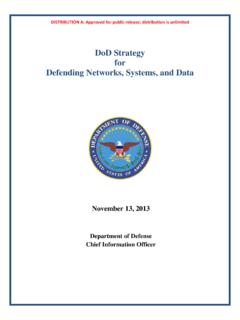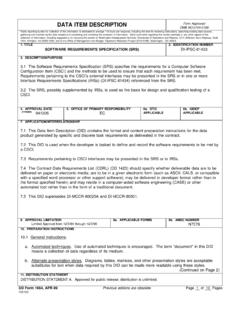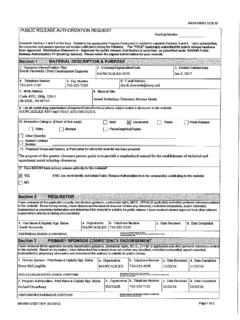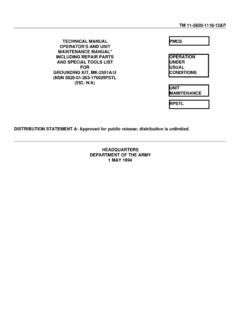Transcription of The Structure of Afghan Names - Karine …
1 MP090315 MITRE PRODUCT The Structure of Afghan Names November 2009 Karine Megerdoomian Contract No.: Project No.:0710D070-AS The views, opinions and/or findings contained in this report are those of The MITRE Corporation and should not be construed as an official Government position, policy, or decision, unless designated by other documentation. approved for public release ; distribution unlimited. 2010 The MITRE Corporation. All Rights Reserved. distribution Statement A": approved for public release 10-4604, distribution Unlimited i Abstract This report provides a description of the Structure of Afghan Names . Person Names in Afghanistan often consist of a compound first name . Most people lack a last name and are generally referred to by their tribal affiliation, place of birth, profession, or honorific titles.
2 However, last Names are more prevalent in urban and more educated families. The report discusses the various components of person Names such as titles, honorifics, the internal Structure of the name , and various forms of address. It also describes some of the issues that arise in the transcription of Afghan Names into English due to a lack of standardization and dialectal differences in the pronunciation. distribution Statement A": approved for public release 10-4604, distribution Unlimited iiTable of Contents 1 Introduction 1 2 The Basic Structure of Names 2 First Names 2 Structure of male Names 2 Structure of female Names 3 Honorifics and Titles 4 Last Names 4 name Structure 6 3 Issues in Transcription 6 Segmentation Differences 6 Dialectal Differences 7 Issues in name Transcription 8 4 Forms of Address 8 Patronymic Names 8 Teknonymous Names 8 Kinship Names 9 Nicknames 9 Titles 10 5 Interpreting
3 Afghan Names 10 6 References 11 distribution Statement A": approved for public release 10-4604, distribution Unlimited iii Table of Figures Figure 1 National map of Afghanistan (source: ) 1 Figure 2 - Ethnolinguistic groups in Afghanistan (source: University of Texas, 1997) 5 distribution Statement A": approved for public release 10-4604, distribution Unlimited iv List of Tables Table 1 Dialectal differences in the pronunciation of Names 7 Table 2 Kinship terms 9 distribution Statement A": approved for public release 10-4604, distribution Unlimited 11 Introduction The Structure of person Names in Afghanistan is very different from those found in a Western society. This raises certain issues in the transcription of Afghan Names in the United States.
4 Figure 1 National map of Afghanistan (source: ) Afghans traditionally use only a first name and generally lack a last name . People are often distinguished by their tribal affiliation, place of birth, profession or honorific titles. First Names , in particular male Names , are often compound or double Names such as Ahmad Navid, Bashir Bijan, or Ahmad Khan. This is in a way similar to English Names such as Mary Ellen or Billy Bob. The first Names in Afghanistan often include an Islamic or Arabic component such as Ahmad, Mohammad, and Ali. Although first Names for women may also be of Arabic origin, in general women are given Persian or Pashto Names . Many Afghans that have contact with the Western world adopt a surname. In general, the educated or prosperous families living in urban areas use last Names .
5 In these instances, they generally select a last name that represents their tribal affiliation as in the case of Hamed Karzai. According to Goering (2002), even if an Afghan possesses a last name , the official name generally remains the first name : "An Afghan may change his last name at a whim, but distribution Statement A": approved for public release 10-4604, distribution Unlimited 2altering the first one requires an application to the government and official permission". (Goering 2002, ). Oftentimes, specific forms of address or honorific titles are used in addressing people and behave as part of the proper name . These honorifics generally refer to religious terms ( , Mullah) or occupation ( , Doctor). In addition, there is no standard orthography in Afghanistan and people often write their Names as they are pronounced in their respective dialects.
6 Hence, the same name may be pronounced differently based on the geographic region within the country. The many ways available in transcribing a certain sound into English can also add further variance: the name can be transcribed in many ways including Mohammad, Mohamed, Muhammad, or Mohamad. The lack of orthographic standardization, combined with a high level of illiteracy, gives rise to many discrepancies in the transcription of Afghan Names into English. 2 The Basic Structure of Names First Names Structure of male Names Male first Names generally consist of two parts. Oftentimes, at least one of the parts includes a common name that is usually referred to as a "subordinate name ", such as Mohammad, Abdul, Gholam, Ali, Khan, Jan, Shah, Din, and ullah.
7 Some examples are given below where the subordinate name has been underlined: Examples: Mohamad Nabi, Abdul Ghafoor, Jangi Shah, Ali Madad, Ahmad Khan, Mohammad Nasim, Akhtar Mohammad, Mohammad Sharif, Gholam Sakhi, Khairullah, Habibullah, Mohammad Zaman, Abdul Qadir, Abdul Waleed, Ghulam Hazrat Although the subordinate name is considered as part of the full name , the main name or "proper name " of the person is in general the non-subordinate component. Hence, a person with the name Mohamad Nabi would probably consider his proper name to be Nabi. Sometimes, both parts of the name may be a common name . In these cases, the less frequent name is generally treated as the proper name of the person. Examples: Abdul Ali, Mohammad Ali, Din Mohammad, Jan Mohamad, Khan Mohammad, Abdul Mohammad, Ali Mohammad, Ghulam Mohammad There are also cases where neither component of the name is a common name .
8 Again, the less frequent name is considered to be the "proper name " of the person. Example: Ahmad Zubair (where Zubair is the proper name ) distribution Statement A": approved for public release 10-4604, distribution Unlimited 3 Even though in certain instances the name may include the father's name , this is not necessarily the case. For instance, the Afghan researcher Mohammad Alam gives the following examples from his own family: A boy's given name is usually composed of two parts or morphemes. These parts may or may not be part of the father's name . For example, my name and my younger brother's name each shares with our father's name , shown in the following: My father's name is Sayd Alam. My name is Mohammad Alam. My brother's name is Sayd Agha. My youngest brother's name , however, is Habibullah, which has nothing to do with any of the above Names .
9 [Alam 1975, p. 7] In rare instances, the male may have a single part name . According to Alam (1975, p. 8), this is due to the fact that there is no longer a requirement to include an ancestor's name in the person's name . Examples: Bashir, Farid, Homayun, Khalil, Raheem, Asad, Dawoud Structure of female Names Female Names mostly consist of a single component. Examples: Homa, Zeyba, Fereyba, Laila, Nasrin, Nura, Roya, Zaralasht, Marzia, Meena, Fattema, Shirin, Nazria, Ayesha, Qamar Female Names are sometimes of Arabic origin. Oftentimes these are derived from the male name by adding the / / sound as shown: Examples: Jamil Jamila, Najib Najiba, Hamid Hamida, Halim Halima However, most female Names come from Pashto or Persian origin and often refer to beauty and nature terms.
10 Examples: Wazjmakay 'breeze', Nurani 'shiny', Zarghun/Zarghoona 'green', Torpekay 'brunette', Nasrin 'jonquil', Freshta 'angel', Kawtara 'pigeon', Spogmay/Spozhmay 'moon' There are also female Names that refer to a legendary personality such as the name of the Afghan politician Malalai Joya, which refers to Malalai the Afghan heroine that played an important role in the battle of Maiwand against the British in 1880. In rare instance, female Names may consist of two parts. Examples: Khan Begom, Begom Jan, Gol Khanom distribution Statement A": approved for public release 10-4604, distribution Unlimited Honorifics and Titles In Afghan Persian or Dari, honorifics are often used by both women and men as part of the name as shown in the examples below. Khan can only be used with men's Names while Jan can appear with both female and male Names .






